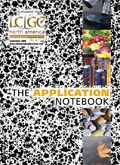Analysis of Geosmin and 2-Methylisoborneol Utilizing the Stratum PTC and Aquatek 70
Geosmin and 2-Methylisoborneol are organic compounds that have a distinct scent.
Geosmin and 2-Methylisoborneol are organic compounds that have a distinct scent. These compounds also have an extremely low odor detection threshold and because of this, many drinking water laboratories require detection levels of below 10 ppt. This application note investigates the detection of Geosmin and 2-Methylisoborneol at a 1 ppt level.
Geosmin and 2-Methylisoborneol have very poor purge efficiencies. In order to detect these compounds down to the 1 ppt level it was necessary to optimize the Purge and Trap (P&T) and Gas Chromatography and Mass Spectrometry (GC–MS) techniques. The experimental and instrument conditions are listed below.

Figure 1: Total ion chromatogram of a 50 ppt Geosmin and 2-Methylisoborneol standard.
Experimental: Instrument Conditions
The Stratum PTC and Aquatek 70 autosampler coupled with a cryofocusing module were connected to an Agilent GC–MS system for analysis. A #1 trap was the analytical trap used. The GC was configured with a J&W Scientific DB-VRX 30 m × 0.250 mm × 1.4 μm column. The MS scanned in the selective ion monitoring (SIM) mode for the Geosmin and 2-Methylisoborneol ions. The temperature profile was 40 °C to 240 °C. Finally, a 25 mL purge volume of 10% (w/v) salt water solution was used.
Calibration
A 50 ppb working calibration standard was prepared in methanol. Calibration standards were prepared in a 50 mL volumetric flask and filled to volume with 10% (w/v) de-ionized salt water solution. The calibration range was 1.0–100ppt. The standards were transferred to headspace free 40 mL vials for analysis. The calibration data was analyzed using Agilent Chemstation software. The %RSD and the linear regression of each compound are outlined in Table I.

Table I: Experimental results summary
Method Detection Limit (MDL), Carryover, and Precision and Accuracy Study
A statistical determination of the MDLs was determined for both of the compounds by analyzing seven replicate standards of a 1 ppt calibration standard. The detection limit is provided in Table I. Furthermore, seven replicate standards of a 10 ppt calibration standard were analyzed in order to determine the precision and accuracy of the experimental conditions. These results are also provided in the Table I.
Conclusions
The Stratum PTC and Aquatek 70 configured with a cryofocusing module performed very well in detecting Geosmin and 2-Methylisoborneol. The linearity of the curve was 1.000 for both of the compounds and the system displayed excellent accuracy and precision results. The 25 mL sample volume and 10% (w/v) salt solution aided in increasing the purge efficiency of both the Geosmin and the 2-Methylisoborneol compounds. Finally, by using SIM analysis with the GC–MS and optimizing the purge parameters of the Stratum PTC, a 1 ppt detection level of the compounds was achieved.

Teledyne Tekmar
4736 Socialville Foster Road, Mason, OH 45040
tel. (800)874-2004; fax (513)229-7050
Website: www.teledynetekmar.com

SEC-MALS of Antibody Therapeutics—A Robust Method for In-Depth Sample Characterization
June 1st 2022Monoclonal antibodies (mAbs) are effective therapeutics for cancers, auto-immune diseases, viral infections, and other diseases. Recent developments in antibody therapeutics aim to add more specific binding regions (bi- and multi-specificity) to increase their effectiveness and/or to downsize the molecule to the specific binding regions (for example, scFv or Fab fragment) to achieve better penetration of the tissue. As the molecule gets more complex, the possible high and low molecular weight (H/LMW) impurities become more complex, too. In order to accurately analyze the various species, more advanced detection than ultraviolet (UV) is required to characterize a mAb sample.















